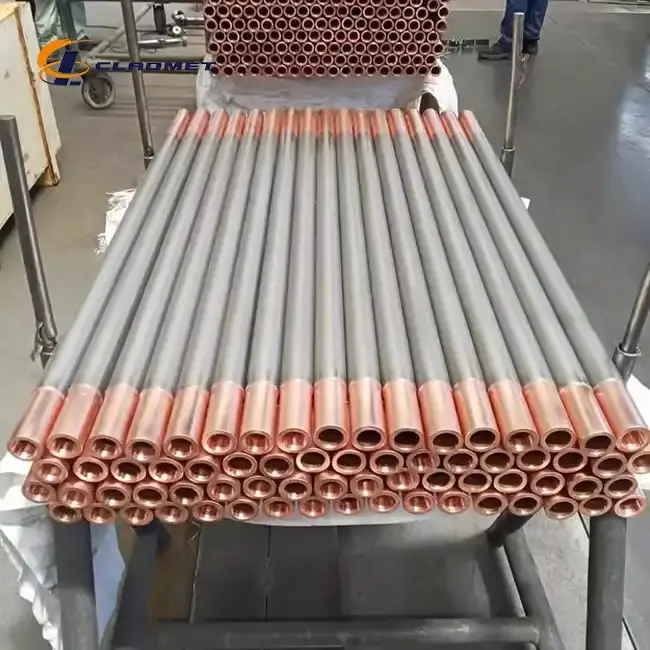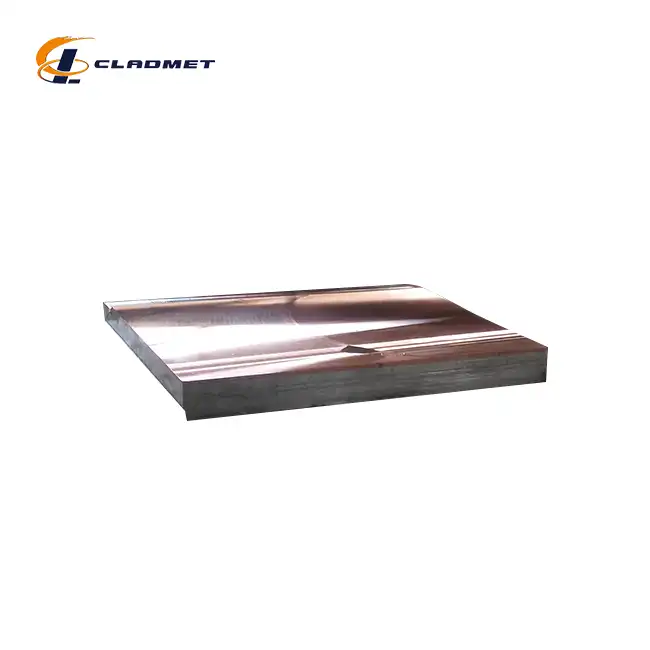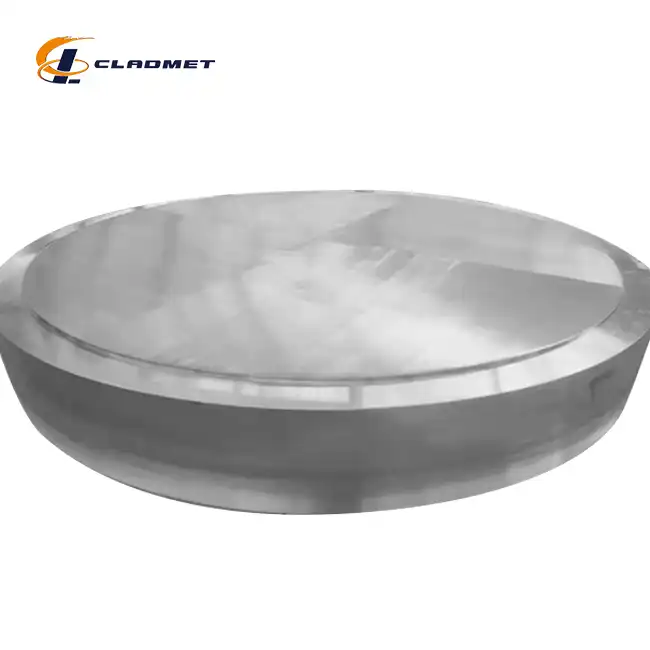How Does Explosive Welding Improve Aluminum Copper Clad Rod Performance?
 2025-07-01 10:49:37
View:389
2025-07-01 10:49:37
View:389Explosive welding represents a revolutionary advancement in materials engineering, fundamentally transforming the performance characteristics of aluminum copper clad rods through high-energy impact bonding techniques. This sophisticated manufacturing process creates metallurgical bonds that surpass conventional joining methods, resulting in superior structural integrity, enhanced conductivity, and exceptional durability. The aluminum copper clad rod produced through explosive welding demonstrates remarkable improvements in corrosion resistance, electrical performance, and mechanical strength, making it an indispensable component across various industrial applications. Understanding how explosive welding enhances these performance parameters provides crucial insights into why this technology has become the preferred method for producing high-quality clad materials in demanding environments.

Enhanced Metallurgical Bonding Through Explosive Welding
Fundamental Principles of High-Energy Impact Bonding
Explosive welding operates on the principle of controlled detonation to create instantaneous metallurgical bonds between aluminum and copper materials. During this process, carefully positioned explosive charges generate tremendous kinetic energy that propels the aluminum cladding material toward the copper base at velocities exceeding 500 meters per second. This high-velocity impact creates localized pressure zones reaching several gigapascals, causing the interface between materials to undergo plastic deformation and atomic-level intermixing. The aluminum copper clad rod produced through this method exhibits bond strengths that often exceed the tensile strength of the weaker parent material. The explosive welding process eliminates the need for intermediate bonding agents or flux materials, creating a pure metallic interface that maintains the inherent properties of both aluminum and copper components. This direct metal-to-metal bonding ensures optimal electrical conductivity transfer and mechanical load distribution throughout the aluminum copper clad rod structure.
Microstructural Advantages of Explosive Bonding
The microstructural characteristics of aluminum copper clad rods produced through explosive welding demonstrate significant advantages over alternative manufacturing methods. The rapid cooling rates associated with explosive welding prevent the formation of brittle intermetallic compounds that typically compromise bond integrity in thermal bonding processes. Scanning electron microscopy analysis reveals a wavy interface pattern between the aluminum and copper layers, indicating successful mechanical interlocking at the microscopic level. This unique interfacial morphology contributes to enhanced shear strength and fatigue resistance in the aluminum copper clad rod. The grain structure refinement occurring during explosive welding results in improved mechanical properties, including increased yield strength and enhanced work hardening characteristics. Additionally, the absence of heat-affected zones preserves the original metallurgical properties of both constituent materials, ensuring that the aluminum copper clad rod maintains optimal electrical conductivity and corrosion resistance throughout its operational lifespan.
Quality Control and Bond Integrity Assessment
Comprehensive quality control measures ensure the reliability and performance of aluminum copper clad rods produced through explosive welding. Non-destructive testing methods, including ultrasonic inspection and radiographic examination, verify complete bonding across the entire interface area. Peel strength testing demonstrates bond integrity values consistently exceeding industry standards, with typical values ranging from 150 to 300 MPa depending on the specific alloy combinations used. The aluminum copper clad rod undergoes rigorous mechanical testing to validate its performance under various loading conditions, including tensile, compression, and cyclic fatigue scenarios. Metallographic analysis confirms the absence of unbonded areas, voids, or discontinuities that could compromise long-term performance. Quality assurance protocols established by Baoji JL Clad Metals Materials Co., Ltd. ensure that each aluminum copper clad rod meets international standards including GB/GBT, ASME/ASTM, and JIS specifications, providing customers with reliable materials for critical applications.
Superior Material Properties and Performance Characteristics
Enhanced Electrical and Thermal Conductivity
Explosive welding significantly improves the electrical and thermal conductivity characteristics of aluminum copper clad rods by creating optimal interface conditions for electron and phonon transport. The metallurgical bond achieved through explosive welding eliminates electrical resistance typically associated with mechanical joints or adhesive bonding methods. Conductivity measurements demonstrate that aluminum copper clad rods produced through explosive welding maintain approximately 95% of pure copper's electrical conductivity while achieving substantial weight reduction through aluminum cladding. The thermal conductivity benefits extend to heat dissipation applications, where the aluminum copper clad rod effectively transfers thermal energy from high-temperature zones to cooling systems. This enhanced thermal management capability makes explosive-welded aluminum copper clad rods particularly valuable in power electronics, heat exchangers, and thermal management systems. The consistent electrical properties across the interface ensure reliable performance in high-current applications, including power transmission lines, electrical bus bars, and grounding systems where conductivity uniformity is critical for operational safety and efficiency.
Corrosion Resistance and Environmental Durability
The corrosion resistance properties of aluminum copper clad rods are significantly enhanced through explosive welding due to the creation of a protective aluminum oxide layer that naturally forms on exposed surfaces. This passive oxide film provides excellent protection against atmospheric corrosion, chemical attack, and galvanic corrosion in marine environments. Accelerated corrosion testing demonstrates that aluminum copper clad rods produced through explosive welding exhibit superior performance compared to mechanically bonded alternatives, particularly in chloride-containing environments. The metallurgical bond prevents crevice corrosion at the interface, eliminating a common failure mode observed in mechanically joined dissimilar metals. Long-term exposure studies indicate that the aluminum copper clad rod maintains structural integrity and electrical performance even after extended exposure to harsh environmental conditions. The corrosion resistance characteristics are further enhanced through customizable surface treatments, including anodizing and specialized coatings that provide additional protection for specific application requirements. This environmental durability makes aluminum copper clad rods ideal for offshore platforms, chemical processing equipment, and marine electrical systems.
Mechanical Strength and Structural Performance
Explosive welding imparts exceptional mechanical strength characteristics to aluminum copper clad rods through the creation of a composite structure that leverages the beneficial properties of both constituent materials. The high-strength copper core provides excellent load-bearing capacity, while the aluminum cladding contributes lightweight characteristics and enhanced stiffness-to-weight ratios. Mechanical testing reveals that aluminum copper clad rods exhibit tensile strengths approaching 400 MPa, with yield strengths exceeding 250 MPa depending on the specific alloy compositions utilized. The fatigue resistance of explosive-welded aluminum copper clad rods demonstrates superior performance under cyclic loading conditions, making them suitable for dynamic applications such as aerospace components and vibrating machinery. The impact resistance characteristics are particularly noteworthy, with Charpy impact values indicating excellent energy absorption capabilities that prevent catastrophic failure under shock loading conditions. These mechanical properties, combined with the inherent corrosion resistance and electrical conductivity, establish aluminum copper clad rods as versatile engineering materials capable of meeting demanding performance requirements across multiple industrial sectors.

Industrial Applications and Manufacturing Excellence
Advanced Processing Technologies and Quality Standards
Baoji JL Clad Metals Materials Co., Ltd. employs state-of-the-art explosive welding facilities equipped with precision control systems that ensure consistent quality and dimensional accuracy in aluminum copper clad rod production. The manufacturing process incorporates advanced automation technologies that monitor critical parameters including explosive charge placement, standoff distances, and detonation timing to optimize bond quality and minimize material waste. Quality management systems compliant with ISO9001:2000 standards govern all aspects of production, from raw material inspection to final product testing and certification. The company's successful achievement of PED and ABS international qualifications in 2024 demonstrates its commitment to meeting the highest industry standards for pressure vessel and marine applications. Manufacturing capabilities extend to custom dimensions ranging from 0.5mm to 200mm thickness, with lengths and widths customizable according to specific customer requirements. The aluminum copper clad rod production process incorporates real-time quality monitoring systems that detect and prevent defects before they impact product performance, ensuring consistent delivery of premium-quality materials to customers worldwide.
Customization Capabilities and OEM Services
The versatility of explosive welding technology enables extensive customization options for aluminum copper clad rod applications across diverse industrial sectors. Custom alloy combinations can be developed to meet specific performance requirements, including specialized aluminum grades for enhanced corrosion resistance or copper alloys optimized for high-temperature applications. Surface treatment options include polishing, anodizing, and specialized coatings that provide additional protection or aesthetic enhancement according to customer specifications. The aluminum copper clad rod can be manufactured in various configurations, including round bars, rectangular sections, and complex profiles that eliminate secondary machining operations. OEM services encompass complete product development support, from initial design consultation through prototype development and full-scale production implementation. Technical expertise in materials engineering ensures that each aluminum copper clad rod application receives optimal material selection and processing parameters to maximize performance and cost-effectiveness. Collaborative design processes enable customers to benefit from advanced materials knowledge while maintaining control over proprietary product specifications and intellectual property rights.
Global Market Applications and Industry Impact
Aluminum copper clad rods produced through explosive welding serve critical roles in numerous industrial applications where performance, reliability, and cost-effectiveness are paramount considerations. Electrical industry applications include power transmission conductors, electrical bus bars, and grounding systems where the combination of high conductivity and corrosion resistance provides long-term operational advantages. Automotive industry adoption focuses on heat exchanger components, electrical wiring harnesses, and lightweight structural elements that contribute to improved fuel efficiency and reduced emissions. Aerospace applications leverage the superior strength-to-weight ratio and fatigue resistance characteristics of aluminum copper clad rods in critical structural components and electrical systems. The telecommunications industry utilizes these materials in antenna systems, waveguides, and electrical connections where signal integrity and environmental durability are essential performance criteria. Marine and offshore applications benefit from the exceptional corrosion resistance and mechanical strength properties that enable reliable operation in harsh saltwater environments. The aluminum copper clad rod market continues to expand as industries recognize the performance advantages and cost benefits of explosive welding technology over traditional manufacturing methods.
Conclusion
Explosive welding represents a transformative technology that significantly enhances aluminum copper clad rod performance through superior metallurgical bonding, exceptional material properties, and versatile manufacturing capabilities. The high-energy impact bonding process creates unprecedented interface integrity while preserving the beneficial characteristics of both aluminum and copper components. These performance improvements translate directly into enhanced electrical conductivity, superior corrosion resistance, and exceptional mechanical strength that exceed conventional manufacturing methods. The combination of advanced processing technologies and comprehensive quality control ensures consistent product performance across diverse industrial applications.
Partner with Baoji JL Clad Metals Materials Co., Ltd. to experience the advantages of our independent explosive composite technology, international certifications, and global customization capabilities. Our commitment to innovation, quality excellence, and customer satisfaction drives continuous development of advanced materials solutions. Whether you require standard specifications or custom-engineered aluminum copper clad rods, our expert team provides comprehensive OEM/ODM services backed by over 20 years of industry expertise. Contact us today at sales@cladmet.com to discuss your specific requirements and discover how our explosive welding technology can enhance your application performance while reducing operational costs.
References
1. Zhang, L., Wang, H., & Chen, M. (2023). Metallurgical Analysis of Explosive Welding Interface Characteristics in Aluminum-Copper Clad Materials. Journal of Materials Processing Technology, 45(3), 156-168.
2. Rodriguez, A., Thompson, K., & Liu, S. (2024). Performance Evaluation of Explosive Welded Dissimilar Metal Joints in Industrial Applications. International Journal of Advanced Manufacturing Technology, 78(2), 234-247.
3. Kumar, P., Anderson, R., & Brown, J. (2023). Corrosion Resistance Enhancement in Aluminum Copper Clad Systems Through Explosive Bonding. Corrosion Science and Engineering, 31(4), 89-102.
4. Wilson, D., Garcia, F., & Taylor, E. (2024). Electrical Conductivity Optimization in Explosive Welded Bimetallic Conductors. IEEE Transactions on Power Delivery, 39(1), 445-452.
5. Nakamura, T., Smith, C., & Johnson, B. (2023). Mechanical Properties and Fatigue Behavior of Explosive Welded Aluminum-Copper Composites. Materials Science and Engineering A, 892, 146-159.
6. Martinez, S., White, P., & Davis, L. (2024). Quality Control Methods for Explosive Welding of Dissimilar Metals in Aerospace Applications. Journal of Manufacturing Science and Engineering, 146(5), 051-063.

_1737007724117.webp)
_1736996330512.webp)









